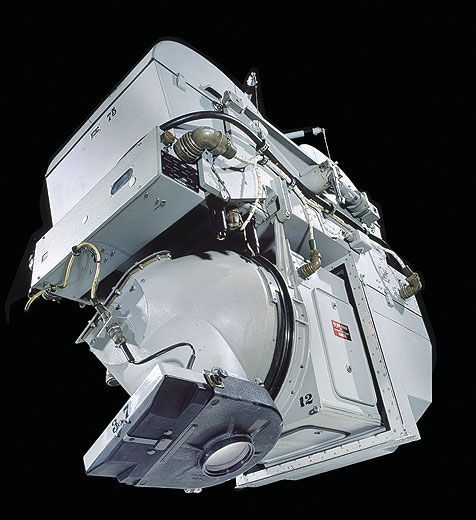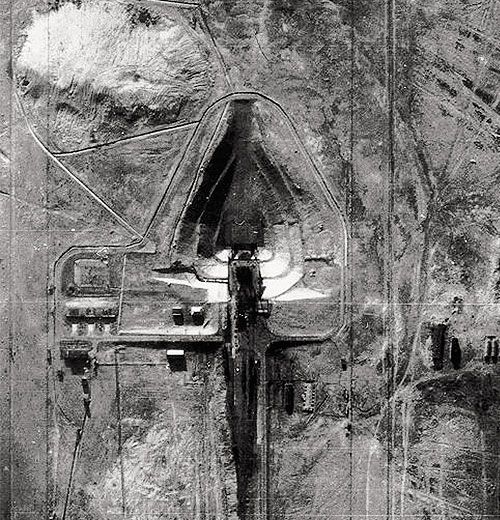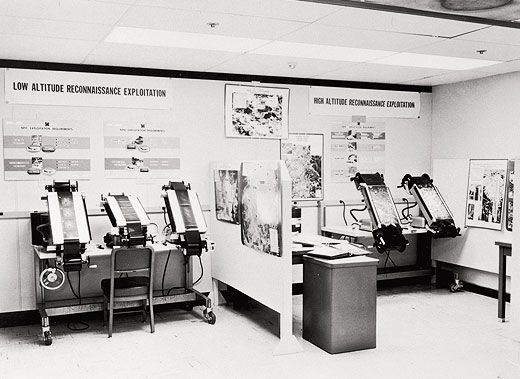Project Equine
…And the high-tech horse it rode in on.
:focal(186x171:187x172)/https://tf-cmsv2-smithsonianmag-media.s3.amazonaws.com/filer/Project_Equine_1_FLASH.jpg)
In the early 1950s, the Central Intelligence Agency and Lockheed were working to bring the U-2, an unprecedented high-altitude, long-range aircraft, into reconnaissance operations. The CIA’s young Dino Brugioni was instrumental in establishing the agency’s National Photographic Interpretation Center in Washington, D.C. In this adaptation from his latest book, Eyes in the Sky—Eisenhower, the CIA and Cold War Aerial Espionage (Naval Institute Press, 2010), Brugioni describes the early years of NPIC.
On December 13, 1954, Allen Dulles, director of the Central Intelligence Agency, and Richard Bissell, CIA manager of the Lockheed U-2 development program, briefed CIA photo interpreter expert Arthur Lundahl on Project Aquatone, the code name for the U-2 project. Bissell was extremely security-conscious and incorporated a number of security procedures into the program, a practice referred to in the intelligence community as “mouse-trapping your security.” Bissell instructed Lundahl to prepare a detailed plan for the exploitation of the U-2 images, which would begin arriving in 1956, and gave Lundahl’s staff clearance, under the name Project Equine, to begin setting up a photo intelligence center. Lundahl vowed that photo intelligence would not revert to its pre-war status as a “military stepchild.” He envisioned his new organization as a wheel, with photo interpreters as the hub and other personnel with diverse talents and disciplines as the spokes helping to turn it.
Lundahl provided the inspiration, visionary zeal, and technical expertise that would hold the Photographic Intelligence Division together and revolutionize the photo interpretation process. I first met him in the early 1950s, when we each represented our organizations—he, the Navy, and I, the CIA—in ground photo conferences held at the Aeronautical Chart and Information Center in the old Midway Building in Washington, D.C. Lundahl and I had numerous discussions about photography. I was impressed with his technical knowledge, and he was impressed with my knowledge of Soviet targets. After the CIA hired him, he told me that he wanted me to be a part of his new organization.
In January 1955 Lundahl chose Charles Frost Camp, the dean of men at Dartmouth, who had been a U.S. Marine Corps major in World War II, to be the division’s executive officer and to hire the men and women who would be the heart of the division. Camp might talk to you as a dean, but more often he spoke as a major. I was given the role of preparing briefing boards that would summarize the U-2 images and Lundahl’s notes to go with them. Camp said that he would get me all of the security clearances that Lundahl had. Then he added, “It’s up to you that Lundahl is provided the proper information. If he gets his ass in a sling, I’ll fire yours.” That kind of Marine admonition gets attention.
The 12 officers selected for the cadre, facetiously labeled “Lundahl’s apostles,” began planning an organization to extract information from U-2 missions. Lundahl excited us with his promise that “we have the opportunity to do something extraordinary with one of the most challenging tasks we have ever undertaken. We will have a seat on the 50-yard line of history.”
The U-2 made its maiden flight on August 4, 1955. A few months later, pilots were regularly reaching 70,000 feet. The U-2 was being tested in three ways. First and foremost were the airframe and its engine. If a flameout should occur over enemy territory, the pilot would have to descend to about 35,000 feet to restart the engine. The U-2 could glide about 1,000 miles from its top altitude, but at low altitudes it would be vulnerable to both fighters and anti-aircraft fire. (Bissell liked to tell the story of a pilot on a training mission who had a flameout over Tennessee and glided to Albuquerque.) Initial concern that contrails produced by the U-2 at operational altitudes could make the aircraft identifiable proved unfounded; planes flying above 55,000 feet did not produce them. The second test involved the physical and mental condition of the pilot after 10-hour training missions over the United States. The third was the cameras: Could they expose a 6,000-foot reel of film properly without malfunctioning or tearing the film? The mission of all reconnaissance pilots is to fly the mission track as ordered and to get the prime target as close as possible to nadir (the point on a photograph that is directly below the camera when the photo is taken). At nadir, interpretation and measurements of the photo are the most precise. To get the aircraft in position, the pilot must know the technical capabilities of the cameras. The cameras, which were preset for proper exposure at the height and the speed of the aircraft, were installed in the sensor bay of the U-2.
The initial missions were flown with the trimetrogon A camera, which consisted of three cameras—one vertical and two oblique—each with a focal length of 24 inches. The A camera, a modification of existing cameras, was used because it could be produced expeditiously. The B camera was a high-altitude camera designed to take pictures of an extremely large area of Earth’s surface. On most missions the camera took pictures in seven discrete positions, from horizon to horizon. The camera stopped momentarily at each position, took a picture, then proceeded to the next position until it had photographed the entire area from the horizon on the right to the horizon on the left. But there was a problem with the B camera. When each frame was on the platen for exposure, the frames could not be touching and a thin metal strip kept them apart. This gap resulted in a loss of about 500 feet of imagery at nadir. When a pilot flew precisely over a target, there would be an imagery gap exactly where the image was most important. Pilots were later instructed to fly slightly to the right or left of a target to prevent a gap over a prime target.
The U-2 test program commenced in earnest in 1955. Lundahl visited Area 51 in southern Nevada and said that witnessing U-2 takeoffs and landings there was akin to watching a Keystone Kops comedy. The frail-looking aircraft reminded him of a “black vulture on crutches.” To properly test the cameras, film, pilots, and even the U-2 itself, long missions were flown from the west coast to destinations all over the United States. A routine round-trip training flight would begin at Area 51 and range all over the country, covering a 2,000-mile radius. Several missions were flown from bases on the east coast. President Dwight D. Eisenhower was kept fully informed, and Bissell and Lundahl periodically showed him briefing boards of these test flights. On one such mission we asked that the U-2 be flown over the president’s home at Gettysburg, Pennsylvania. A glassed-in porch added to the house in 1955 served as the main recreational area, with a television set, poker table, bar, and comfortable chairs for friendly chats with guests. Outside the house was the president’s putting green. Nearby was a large barn. The U-2 obtained a clear picture of Eisenhower’s farm, and we created a briefing board. Lundahl pointed out the new porch addition, then Eisenhower grabbed the board and began a literal tour of the area. He took great delight in identifying objects about the farm, particularly his prized Angus cattle; he even pointed out a bull.
We also had U-2 photos of Senator Richard Russell’s birthplace in Winder, Georgia, along with Washington and New York. On an enlarged photograph of the Capitol, Lundahl pointed out the stripes delineating parking places. We could even identify car models. “I saw photographs of our own Capitol,” Bissell recalled in his memoir, “in which the photo analysis counted the number of cars and identified their makes—all this from about thirteen miles up.”
As the U-2 program progressed, Bissell realized he needed an organization to recommend targets for U-2 flights. He created an informal Ad Hoc Requirements Committee (ARC) to select the highest-priority targets. Initially comprising representatives of the CIA, Army, Navy, and Air Force, ARC was an open forum where the representatives could present, discuss, and debate the prioritization of intelligence targets. At the first ARC meeting it was agreed that the number-one issue was the “bomber gap,” and the majority of targets selected were Soviet long-range bomber bases and large urban areas in the western U.S.S.R. For subsequent missions, each service representative would argue vociferously for targets of specific concern to that service. James Q. Reber, ARC’s first chair, would listen patiently to the arguments, reflect on them, and then decide which flight track would be the most efficacious in satisfying intelligence needs relative to the overall objective.
When the mission’s flight plan was complete, Reber composed a brief justification memo for Eisenhower’s approval. One paragraph would cover the potential for missile information; another, nuclear information; the third, bombers; and the fourth, the number and types of bonus targets that could be accrued. Bissell noted that the president did not just rubber-stamp the memo: “On at least a couple of occasions he exercised his authority as commander in chief by suggesting the flight plan be altered. He was a cautious man who liked to have contingencies under his control.”
U-2 missions had to be flown over areas free of clouds, so weather conditions were a primary consideration in planning the missions. Ironically, the missions were flown primarily on the basis of information obtained from intercepted and decoded Soviet weather reports. Hyko Gayikian, a chief meteorologist, noted that data for weather over the Soviet Union, while not classified, was sparse. The Soviets transmitted to the outside world only the absolute minimum of information required by the Meteorological Committee of the International Civil Aviation Organization. However, their internal communications were so archaic that they collected their weather data and transmitted it to Moscow using the same carrier waves as radio transmissions. Both the United States and the United Kingdom surrounded the Soviet Union with radio listening sites and intercepted Soviet data. It was transmitted to the United States by wire, so we had complete weather data for the U.S.S.R. several hours before the Soviets did.
As we began processing the first U-2 imagery, a search was being made for a permanent home for the division. One of the requirements was a plentiful supply of water for photo processing. The two most promising sites were the abandoned Sunshine Arcade laundry and the upper floors of the Steuart Motor Car Company building. We settled on the latter. The nondescript Steuart Building was at 5th and K Streets, NW, a crime-ridden area of Washington. The upper four floors would become the division’s home; the lower floors would be occupied by the Steuart automobile sales and repair shops along with the Steuart Real Estate office. “The Steuart Building was not the finest building in the world to work in,” Lundahl recalled. “There was no place to eat, no place to park, no air conditioning, our people were getting mugged on the streets before it was fashionable. I guess the best thing you could say is that it had wonderful security cover, because I am sure nobody would ever believe that anything of any importance to the United States could be taking place in the trashy neighborhood.”
The results from the U-2 test missions were astounding, but the division had only World War II stereoscopes and tube magnifiers with which to view the images. Photographic resolution is the size that an object can be seen on a photograph; a two-foot resolution indicates that a two-foot-square object is visible. The most generally used technical measure of resolution is the number of lines per millimeter distinguishable on the film. A photographic line is actually a pair of lines, one black and one white, that can be seen and counted within one millimeter under magnification. The more lines per millimeter, the better the resolution and the larger the enlargement possible. During World War II, for example, cameras could obtain about 20 lines per millimeter. The U-2 film was resolving an astonishing 100 lines per millimeter. Advances in film technology later produced resolutions of 125 to 150 lines. The U-2 missions were resolving about two and a half feet at nadir. With that type of quality, it was possible to measure nuclear weapons loading pits, new aircraft, missiles, and the like.
Lundahl loved to quote Amron H. Katz, the distinguished scientist from the RAND Corporation: “You take a multi-million- dollar airplane, $100,000 worth of cameras, take off on a hazardous, expensive mission, get back…run the film through comparably expensive processing machinery…and when the photo interpreter gets around to extracting the information on the photography he uses a 10-cent magnifying glass.”
Now a retired CIA senior analyst, Dino Brugioni briefed Presidents Eisenhower through Ford. He flew 66 bombing missions in World War II.
Adapted from Eyes in the Sky—Eisenhower, the CIA and Cold War Aerial Espionage, Naval Institute Press, 2010. Reprinted by permission.

/https://tf-cmsv2-smithsonianmag-media.s3.amazonaws.com/filer/Project_Equine_1_GALL.jpg)

